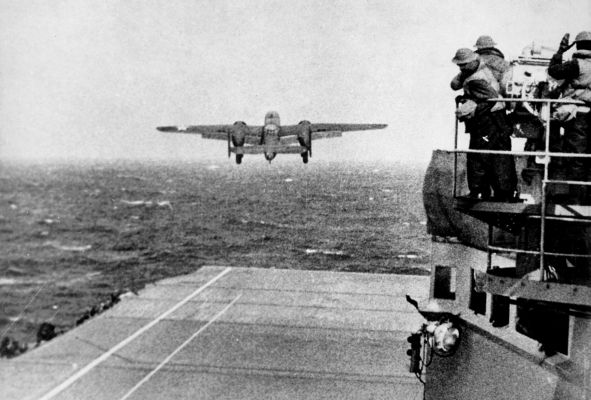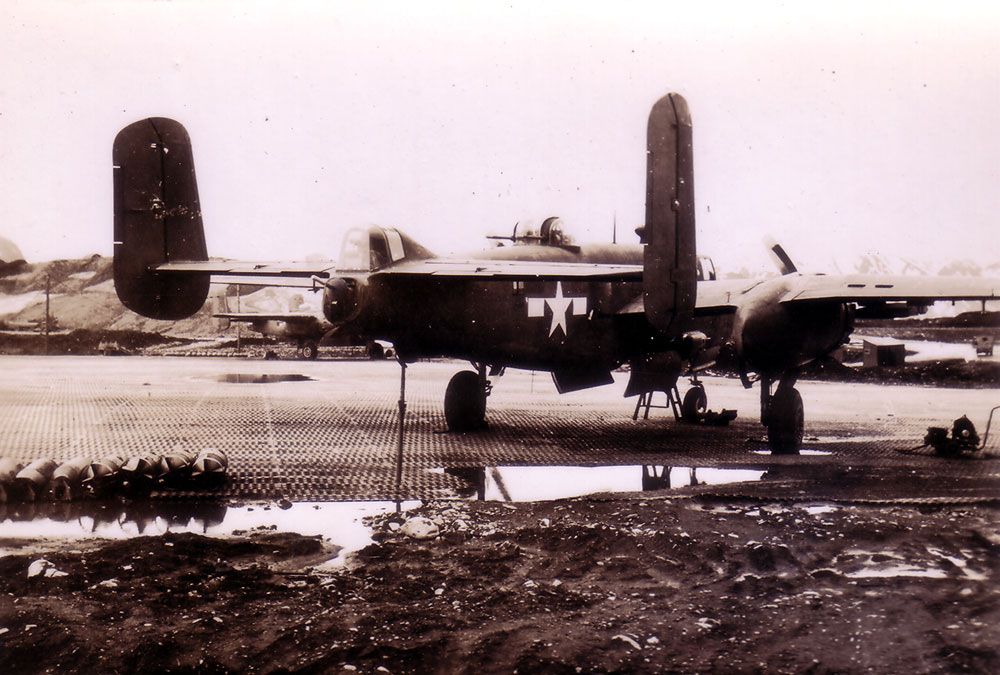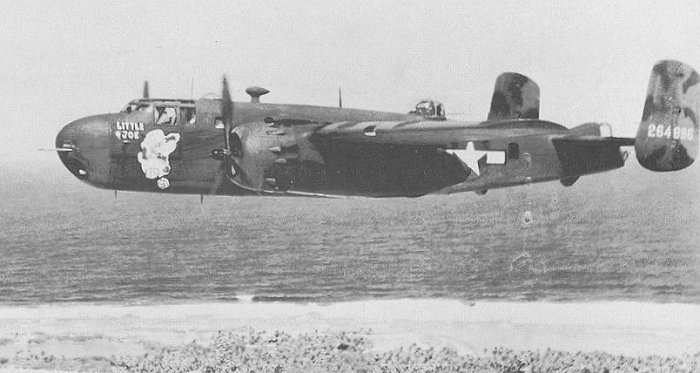
Posted on 04/16/2014 12:17:41 PM PDT by Retain Mike
One week after Pearl Harbor, President Roosevelt began pressing the U.S. military to immediately strike the Japanese homeland. The desire to bolster moral became more urgent in light of rapid Japanese advances. These included victories in Malaya, Singapore, the Philippines, Wake Island, and the Dutch East Indies, as well as sinking the British battleships Prince of Wales and Repulse.
Only improbable ideas warranted consideration, because submarines confirmed Japan placed picket boats at extreme carrier aircraft range. One idea even involved launching four engine heavy bombers from China or Outer Mongolia to strike Japan and fly on to Alaska. Captain Francis Low, a submariner, was the first to broach the idea of flying Army Air Corps medium bombers from an aircraft carrier. Jimmy Doolittle sold his boss at the Pentagon on the idea, with the proviso he would return to Washington for some real work.
By mid-January 1942 Doolittle began assembling the planes and crews. As one of the first MIT aeronautical engineering graduates he chose the B-25B. Since few Army personnel underwent training or had experience for operations involving ocean navigation, crews were chosen from the 17th Bombardment Group flying anti-submarine patrols from the newly build airfield at Pendleton Oregon.
Unaware of this pending mission, the 24 crews flew to Minneapolis where the bombers received extensive modifications. Installing auxiliary fuel tanks increased capacity over 70%. Range eventually increased from about 1,000 to 2,500 miles by also utilizing flying configurations and practices designed to conserve fuel. Increased fuel weight then required removing a 230 pound liaison radio. The lower twin 50cal. ball turret was later removed at Eglin Field in Florida saving 600 pounds. An armored 40gal fuel tank was then inserted. Cameras were installed to record bombing results.
While in Minneapolis Captain David M. Jones told the officers their destination was not Columbia, South Carolina for anti-submarine patrol. They were asked to volunteer for a dangerous, important, and interesting mission for which no information could be given. Nearly everyone volunteered even though most were new to their trade. Of the 16 pilots Doolittle actually took on the raid, only five had won their wings before 1941 and all but one was less than a year out of flight school.
Jimmy Doolittle, now a Lieutenant Colonel, met all 140 of them in Eglin’s operation’s office. He said, “If you men have any idea that this isn’t the most dangerous thing you’ve ever been on, don’t start this training period…..This whole thing must be kept secret. I don’t want you to tell your wives…..Don’t even talk among yourselves about this thing. Now does anyone want to drop out?” Nobody dropped out.
The crews began training with Lieutenant Henry L. Miller, USN (who later became an “Honorary Tokyo Raider”) on Elgin Field 48 days before the raid. The crews used a remote runway flagged to mark available carrier deck length. In three weeks the crews learned to take off at near stalling speeds of 50-60 miles per hour, overloaded, and in just over a football field length. At Pendleton pilots had used a mile long runway to build up speed to 80-90 miles per hour.
As the mission armament officer, Captain Charles Ross Greening improvised substitutes after removal of the top secret Norden bombsight, the lower ball turret and tail guns. At Elgin he and Tech Sergeant Edward Bain designed a substitute bomb sight with two pieces of aluminum. The “Mark Twain” device could be rapidly fabricated in the base metal shop and provided superior accuracy for this low-altitude bombing assignment. On board the Hornet Greening installed a pair of black-painted broom handles in each aircraft's tail cone to intimidate attacking enemies.
Twenty two bomber crews hedgehopped across country to San Francisco. The sixteen crews who reported no problems had their planes lifted aboard ship. Those who reported problems, however minor, were devastated when Doolittle excluded them from the mission.
The Hornet left the U.S. and joined the Enterprise at sea April 13, 1942. Now two of the four American carriers in the Pacific with 14 escorts and 10,000 crew members steamed towards Japan. The Army crews shared quarters with the navy squadrons. Edgar McElroy, pilot of #13 aircraft remembers bunking with two members of Torpedo Bomber Squadron Eight. He later learned that they along with all but one member of the squadron died at the Battle of Midway.
From radio traffic analysis, the Japanese knew carriers that had eluded their six carrier strike force on December 7 were underway somewhere in the Western Pacific. Unbeknownst to the Americans, the Japanese patrolling picket boats were 650 miles, not 300 miles, offshore to provide the intelligence needed for an overwhelming counterattack.
On April 18 the U.S. task force encountered this picket line 170 miles before their planned launch. The pilots rushed to their planes as the ship plowed into the wind and 30 foot swells. Each aircraft received at this last minute 11 extra 5gal gas cans. A Navy officer twirled a flag, listened for the right tone from the revving engines, and felt for the precise moment to release them on the pitching deck. The pilots, who had never flown from a carrier, saw the ship’s bow reaching into a grey sky, and then falling into a dark angry ocean sending salt spray across the flight deck. When released, they quivered down a bucking flight deck keeping the left wheel on a white line to just miss the superstructure by six feet. Every plane lifted safely from a rising deck into the stormy sky; even Ted Lawson who discovered he had launched with flaps up and initially plunged towards the ocean.
The bombers proceeded independently to Tokyo, Yokohama, Yokosuka, Nagoya and Kobe. While underway the industrial targets had been briefed by Lt Stephen Jurika who was naval attaché in Tokyo 1939-1941. He imparted information from not only his own travels, but from a Soviet counterpart who had spent several years researching possible bombing targets. The Soviet Union was long aware of Japan’s plans to attack both China and U.S.S.R. (strike north), or to attack colonial possessions of the U.S, Netherlands and Britain (strike south).
Colonel Doolittle considered the raid a failure. Every plane had been lost. One plane and crew was interred in the Soviet Union. Fifteen crashed in China resulting in three crewmen deaths. Eight crew members were captured of whom three were executed and one starved to death in Japanese prison camps. He saw the raid as secondary to the bombers safely arriving and providing Chennault’s air force an offensive capability.
However, the raid proved a crucial moral victory demonstrating Americans could do the impossible even if their battle fleet was blasted to wreckage, and they were losing an army in the Philippines. The Imperial Navy suffered a devastating loss of face, because Admiral Yamamoto had guaranteed the Emperor that the Americans would never attack their home islands.
Charles Ross Greening, Colonel United States Air Force http://www.arlingtoncemetery.net/crgreening.htm
Greening, Colonel Charles Ross (1914-1957), HistoryLink.org Essay 10320 http://www.historylink.org/index.cfm?DisplayPage=output.cfm&file_id=10320
Captain David M. Jones http://en.wikipedia.org/wiki/David_M._Jones
Letters from the Precipice of War (Steven Jurika) http://www.usni.org/magazines/navalhistory/2014-01/letters-precipice-war
Sorge: A Chronology (Excerpts 1942) http://richardsorge.com/excerpts/1942/index.html
The Official Website of The Doolittle Tokyo Raiders http://doolittleraider.com/
Doolittle Raiders 70th Anniversary: http://www.washingtontimes.com/specials/doolittles-tokyo-raid/ http://www.bing.com/images/search?q=doolittle+raiders+70th+anniversary&qpvt=doolittle+raiders+70th+anniversary&FORM=IGRE http://doolittlereunion.com/
Pendleton Field http://www.ohs.org/education/oregonhistory/historical_records/dspDocument.cfm?doc_ID=C9A94F93-E10A-57A0-B694B0AFFE69184C
A final toast for the Doolittle Raiders http://www.cnn.com/2013/04/14/opinion/greene-doolittle-raiders
Jonna Doolittle Hoppes "Jimmy Doolittle Raid" presentation at Historic Flight Foundation http://www.youtube.com/watch?v=fgt8PMoRGG8
Doolittle Raiders: The Last Reunion (VIDEO) http://salem-news.com/articles/may302013/doolittle-raiders-rn.php
Doolittle Raider forum, etc. http://www.doolittleraider.com/forum/viewtopic.php?f=128&t=579 http://www.dontow.com/2012/03/the-doolittle-raid-mission-impossible-and-its-impact-on-the-u-s-and-china/ http://www.historynet.com/countdown-to-the-doolittle-raid.htm
So true. My boys would have never been allowed to play dadge ball in grade school.




Thanks for the reminder — 72 years ago tomorrow.
ping.
Thanks for the ping — lest we forget.
And one of my favorite movies as well...:)

What a sweet plane.
 yup, great movie about real heroes...
yup, great movie about real heroes...
Disclaimer: Opinions posted on Free Republic are those of the individual posters and do not necessarily represent the opinion of Free Republic or its management. All materials posted herein are protected by copyright law and the exemption for fair use of copyrighted works.